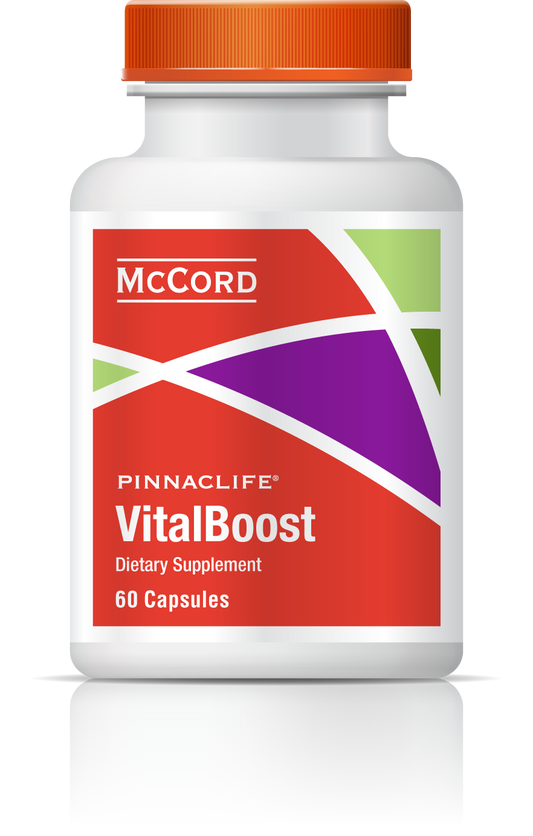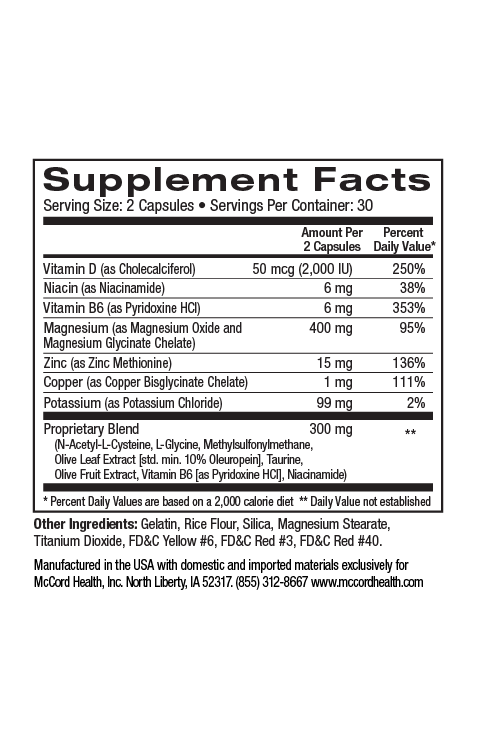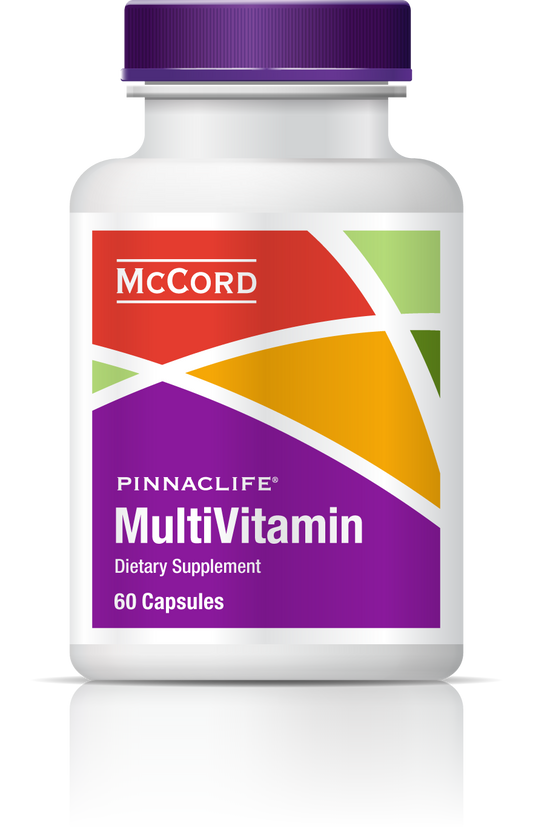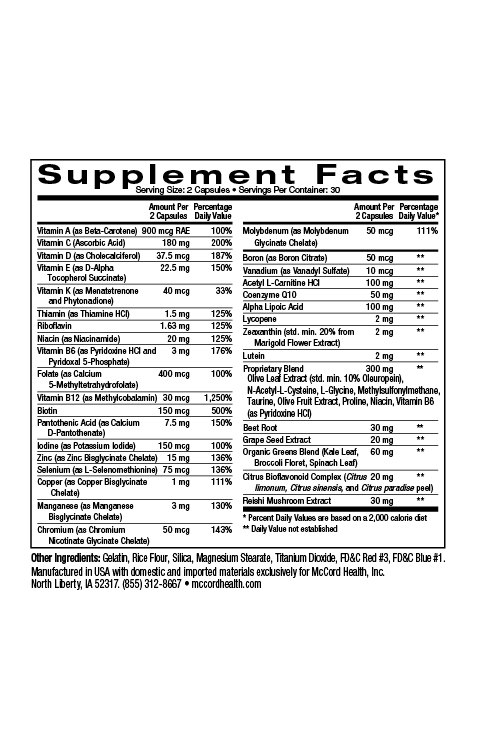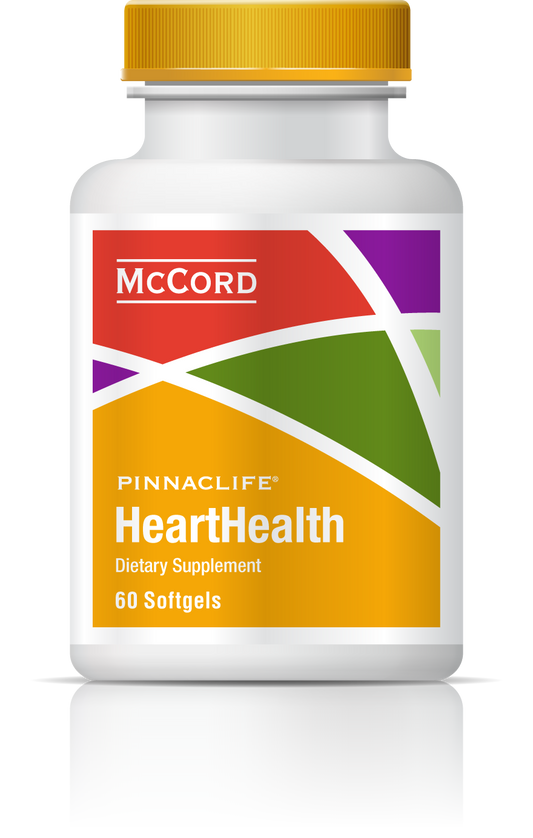Cells contain biological engines called mitochondria that convert food into energy the body can use. Healthy mitochondria utilize a complex system of vitamins, minerals, essential lipids, electrolytes, amino acids, antioxidants to function properly. Nutritional deficiencies lead to dysfunction, cell death, disease, and aging.
- Cells contain tiny "engines" called mitochondria that create the energy needed to function
- Healthy mitochondria require a wide array of vitamins, minerals, amino acids, and antioxidants to function properly
- When mitochondria don't function properly it creates oxidative stress, inflammation, cell death, and diseases
- Nutritional deficiencies contribute to poorly functioning mitochondria
- Proper nourishment through diet and supplementation can help support mitochondria and keep them functioning properly
Tell Me More
The engine is arguably the most important part of the car. If it breaks down, the car loses the ability to perform its primary function. There are hundreds of small components within the engine that need to work in perfect synchronization and when just one piece of that machine is out of sync, the whole engine can shut down.
Most of the cells in your body contain even more complicated “engines” called mitochondria (red blood cells do not). Cells that require the most energy like those found in the brain, heart, kidneys, retinas and muscles may contain thousands of mitochondria in each cell.1 These tiny “engines” are responsible for converting the calories from dietary fats, proteins, and sugars into the energy that drives every process in your body.2
Instead of pistons, belts, spark plugs, valves, and fuel injectors that make a car engine run, the mitochondria rely on perfect synchronization of a complex system called the “electron-transport chain” (ETC). The ETC is built with a combination of proteins, vitamins, minerals, co-enzymes, antioxidants, amino acids, and fatty acids.
When we are deficient in certain nutrients, the ETC does not work as well so mitochondria begin to malfunction and literally break down, causing the cell to die.2–6 It is no different than removing key components like spark plugs and pistons out of your engine and expecting it to run normally – it doesn’t work!
Cellular "Engine Breakdown" Causes Cell Death
Cells typically die one of two ways: necrosis or apoptosis (app-uh-toe-sis). Necrosis is when a cell dies due to things like mitochondrial dysfunction and trauma.7,8 Think of this like your car’s engine exploding and sending parts flying around causing damage to other parts of the car. When cells die via necrosis, they similarly “explode” releasing metabolic waste products, free radicals, and inflammatory compounds causing inflammation and damage to surrounding cells and tissues.
On the other hand, when a cell dies of apoptosis it literally disassembles itself into tiny pieces called “blebs” that get absorbed and reused by surrounding cells.7,8 Think of this as an engine being carefully taken apart piece-by-piece so the parts can be reused to repair or build a new vehicle. This is the way that cells are supposed to die, and they are actually genetically programmed to undergo this process when the time is appropriate.
Promoting Healthy Mitochondria
When you provide your cells and the mitochondria with the materials they need, they are more likely to undergo apoptosis instead of necrosis. This means providing them with an adequate supply of the vitamins, minerals, fatty acids, amino acids, and antioxidants that are needed for each and every component. Better yet, some nutrients have even been shown to turn on genetic pathways that help make the system work even better and function as a remedy against destructive cellular processes.
Some of the major patented effects of Proprietary Blend relate to the effects that it has on specific genes for potent mitochondrial antioxidants.4,9–12 This combination of hydroxytyrosol from olives with amino acids, antioxidants, and other vital components of the electron transport chain including vitamins B3 and B6 has been shown to increase the lifespan of cells by as much as 20% while directing them towards apoptosis instead of necrosis when their lifespan is complete. Proprietary Blend ImmuneHealth contains the highest dose of Proprietary Blend in the entire product line. There can be even more benefit when Proprietary Blend is combined with other vital nutrients found in Pinnaclife nutritional supplements including:
- Coenzyme Q10 (Co-Q10)6,13 in Proprietary Blend Total Health Multivitamin
- Acetyl-l-carnitine14 in Proprietary Blend Total Health Multivitamin
- Magnesium15 in Proprietary Blend BoneHealth, CalmMind, BrainHealth, SleepHealth, and JointHealth
- L-taurine16–18 in all products, but highest doses in Proprietary Blend BrainHealth and EnergyBoost
- Melatonin19 in Proprietary Blend SleepSupport
When you incorporate McCord Research Proprietary Blend Nutritional Supplements into your daily routine, it’s like you are providing your mitochondria with a supply of new parts plus a team of mechanics that are constantly working to keep your cellular engines running smoothly and efficiently.
References
- Mitochondrion. Br Online Encycl. 2014:1–2.
- Wallace DC. A Mitochondrial Paradigm of Metabolic and Degenerative Diseases, Aging, and Cancer: A Dawn for Evolutionary Medicine. Annu Rev Genet. 2005;39(359):1–51.
- Müller WE, Eckert A, Kurz C, Eckert GP, Leuner K. Mitochondrial dysfunction: common final pathway in brain aging and Alzheimer’s disease--therapeutic aspects. Mol Neurobiol. 2010;41(2-3):159–71.
- Jain A, Mårtensson J, Stole E, Auld PA, Meister A. Glutathione deficiency leads to mitochondrial damage in brain. Proc Natl Acad Sci U S A. 1991;88(5):1913–7.
- Galea E, Launay N, Portero-Otin M, et al. Oxidative stress underlying axonal degeneration in adrenoleukodystrophy: a paradigm for multifactorial neurodegenerative diseases? Biochim Biophys Acta. 2012;1822(9):1475–88.
- Matthews RT, Yang L, Browne S, Baik M, Beal MF. Coenzyme Q10 administration increases brain mitochondrial concentrations and exerts neuroprotective effects. Proc Natl Acad Sci U S A. 1998;95(15):8892–7.
- Cheema N, Herbst A, McKenzie D, Aiken JM. Apoptosis and necrosis mediate skeletal muscle fiber loss in age-induced mitochondrial enzymatic abnormalities. Aging Cell. 2015.
- Majno G, Joris I. Apoptosis, oncosis, and necrosis. An overview of cell death. Am J Pathol. 1995;146(1):3–15.
- Sarsour EH, Kumar MG, Kalen AL, Goswami M, Buettner GR, Goswami PC. MnSOD activity regulates hydroxytyrosol-induced extension of chronological lifespan. Age (Omaha). 2012;34:95–109.
- Nguyen D, Hsu JW, Jahoor F, Sekhar R V. Effect of increasing glutathione with cysteine and glycine supplementation on mitochondrial fuel oxidation, insulin sensitivity, and body composition in older HIV-infected patients. J Clin Endocrinol Metab. 2014;99(1):169–77.
- Dringen R. Metabolism and functions of glutathione in brain. Prog Neurobiol. 2000;62(6):649–71.
- Hardy TM, Tollefsbol TO. Epigenetic diet : impact on the epigenome and cancer. Epigenomics. 2011;3(4):503–18.
- Haas RH. The evidence basis for coenzyme Q therapy in oxidative phosphorylation disease. Mitochondrion. 2007;7 Suppl:S136–45.
- Ames BN, Liu J. Delaying the mitochondrial decay of aging with acetylcarnitine. Ann N Y Acad Sci. 2004;1033:108–16.
- Volpe SL. Magnesium in disease prevention and overall health. Adv Nutr. 2013;4(3):378S–83S.
- Chang L, Xu J, Yu F, Zhao J, Tang X, Tang C. Taurine protected myocardial mitochondria injury induced by hyperhomocysteinemia in rats. Amino Acids. 2004;27(1):37–48.
- Hansen SH, Andersen ML, Cornett C, Gradinaru R, Grunnet N. A role for taurine in mitochondrial function. J Biomed Sci. 2010;17 Suppl 1:S23.
- El Idrissi A. Taurine increases mitochondrial buffering of calcium: role in neuroprotection. Amino Acids. 2008;34(2):321–8.
- León J, Acuña-Castroviejo D, Escames G, Tan D-X, Reiter RJ. Melatonin mitigates mitochondrial malfunction. J Pineal Res. 2005;38(1):1–9.
Disclaimer: These statements have not been reviewed by the FDA. These products are dietary supplements and are not intended to treat, cure, or prevent any disease. The decision to use these products should be discussed with a trusted healthcare provider. The authors and the publisher of this work have made every effort to use sources believed to be reliable to provide information that is accurate and compatible with the standards generally accepted at the time of publication. The authors and the publisher shall not be liable for any special, consequential, or exemplary damages resulting, in whole or in part, from the readers’ use of, or reliance on, the information contained in this article. The publisher has no responsibility for the persistence or accuracy of URLs for external or third party Internet websites referred to in this publication and does not guarantee that any content on such websites is, or will remain, accurate or appropriate.

